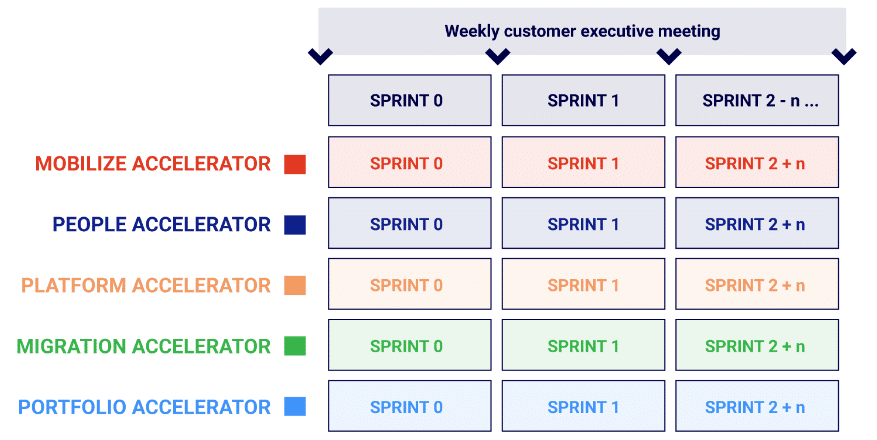AWS Migration Accelerator Program and Well-Architected Framework underpin the journey to success.
With today’s rapidly evolving and highly competitive digital landscape, businesses are increasingly turning to cloud-based services to achieve scalability, flexibility, and cost-efficiency for critical business applications. A major provider of cloud-based services, Amazon Web Services (AWS) offers viable options for businesses of all sizes. However, migrating to AWS may not be something internal IT teams are prepared to tackle.
COFOMO assists customers in assessing and migrating to AWS by employing a strategy centric on the Migration Accelerator Program (MAP) and aligning with the AWS Well-Architected Framework. By leveraging MAP, an exceptional toolkit developed by AWS, we implement a three-phase approach: Assess, Mobilize, and Migrate and Modernize. This meticulous process ensures a seamless migration, with workloads transitioning smoothly in successive phases and waves.

Phase 1: Assess – knowledge becomes power
“Assess,” the first phase in transitioning to cloud-based business, is Conducting a Cloud Readiness Assessment (CRA). This step examines four critical considerations that aid in baselining the benefits and potential challenges of a transition to the Cloud.
- Optimization: Cloud services are billed according to usage, and without a comprehensive evaluation, there is a potential for over-provisioning resources or selecting inappropriate service tiers. Assessing current on-premises infrastructure and any existing cloud environment identifies unnecessary redundancies and potential areas of improvement. A thorough assessment enables stream processes and resource allocation, leading to a more efficient cloud deployment.
- Migration planning: Evaluating the suitability of applications for cloud migration is crucial in identifying which ones can be smoothly transitioned to the cloud environment, which may require modifications, and which should remain on-premises. This assessment is pivotal in determining the seamless integration of applications across different infrastructures. The evaluation ensures uninterrupted continuity of vital business functions during the migration process. Understanding existing infrastructure and resource dependencies is crucial for effective migration planning. An assessment uncovers interconnections and dependencies within systems that must be considered in developing a successful migration plan. Identifying potential risks, challenges, and bottlenecks early in the assessment phase is critical to avoid unexpected issues during the transition phase, like downtime or data loss. Proactively applying this knowledge to drive remediation and mitigation strategies is key to a smooth transition.
- Security and compliance: Integral to the CRA is an evaluation of security and compliance posture, ensuring alignment with AWS best practices and standards. The assessment varies across industries and organizations and is vital for protecting data integrity and ensuring regulatory compliance.
- Change management: Cloud migration frequently necessitates changes to organizational processes and roles. Conducting an assessment identifies where changes to process, training or organizational changes may be required.
In summary, the Assess phase seeks to manage cost, guarantee security and compliance and establish the foundation for a successful and streamlined cloud adoption journey that yields long-term business benefits.
Phase 2: Mobilize
The Mobilize phase is pivotal in the AWS MAP for successfully migrating to the AWS Cloud. It encompasses a comprehensive range of activities and workstreams that establish the resilient foundation for migration.
Objectives of this phase include:
- Application selection and prioritization
- Implementation of best migration practices
- Validation of AWS infrastructure
- Staff training
- Fostering an agile migration process
Significant outcomes of the phase encompass validation of the AWS landing zone, creation of operations model and security playbook, enhancement of skills and knowledge, and cultural readiness within the organization.
During this phase, five accelerator teams are deployed:
- The Mobilize Accelerator team is committed to promoting team engagement and implementing agile project management practices.
- The People Accelerator team specializes in change management. Their focus is to address and navigate the human aspects of the migration process, ensuring readiness and adaptation.
- The Platform Accelerator team is crucial in constructing the technical foundation and is accountable for managing networking and implementing security measures. It works closely with the Landing Zone Accelerator (LZA) to establish a tailored landing zone that aligns with all unique business specifications.
- The Migration team leads the migration of pilot applications to the cloud. Their work ensures the final swift, smooth and complete migration to the cloud.
- The Portfolio Accelerator team is accountable for identifying assets earmarked for migration leveraging necessary tools, including Cloudamize. The team owns workload categorization and meticulous rightsizing, aiming to optimize costs and maximize efficiency.
Cloud Migration Roadmap and timeline

In summary, the Mobilize phase detangles the complexities of establishing a cloud migrations strategy with a focused teams-lead approach.
Phase 3: Migrate and Modernize
The Migrate and Modernize phase includes two primary objectives: migrating workloads to the AWS cloud and modernizing applications for enhanced performance and efficiency. In this phase, priority is given to optimizing application performance and efficiency during migration to the AWS cloud.
Using AWS Well-Architected Framework simplifies the managing and optimizing of migrated or modernized workloads in the cloud. This comprehensive blueprint emphasizes the key principles and best practices for designing and running workloads and setting a solid foundation. Organized around six fundamental pillars, it addresses essential aspects of cloud architecture and operations, empowering businesses to achieve peak performance and operational efficiency.
- Operational excellence is a foundational pillar driving efficiency and continuous improvement within organizations. It centres around streamlined operations, task automation, and optimized processes. Key components entail automating changes, promptly responding to events, and establishing robust daily management standards. By embracing this approach, organizations ensure seamless operation of their cloud workloads, reduce manual intervention and swiftly adapt to evolving demands.
- Security is paramount in the realm of cloud computing. The security pillar prioritizes protecting information and systems, encompassing critical aspects such as data confidentiality, integrity, user access permissions, and establishing controls for detecting and responding to security events. Implementing strong security measures ensures valuable cloud assets and data remain protected.
- The reliability pillar emphasizes consistent performance and quick recovery of workloads. Essential considerations include distributed system design, comprehensive recovery planning, and flexibility to meet dynamic requirements. Organizations can minimize downtime, guarantee high availability, and enhance overall service quality by prioritizing reliability.
- Performance efficiency is a critical element in allocating IT and computing resources effectively. It includes selecting appropriate resource types and sizes that align with specific workload requirements. Monitoring performance metrics and responding with adaptive measures to evolving business needs is crucial for maintaining optimal efficiency, responsiveness and availability.
- Cost optimization involves efficiently managing cloud expenses, including understanding spending patterns, resource allocation control, selecting suitable types and quantities of resources, and scaling to align with business demands, all while avoiding over-provisioning. By implementing cost optimization practices, organizations can maximize their return on investment in the cloud while eliminating unnecessary expenses.
- The sustainability pillar emphasizes mitigating the environmental impact of running cloud workloads. It adopts a shared responsibility model, leveraging a comprehensive understanding of the environmental footprint and optimizing resource utilization to minimize downstream impacts. Aligning with ethical and sustainable eco-friendly cloud practices fosters a greener and more responsible cloud ecosystem.
Embracing these principles allows organizations to create robust, secure, cost-efficient, and environmentally sustainable cloud architectures that foster innovation and achieve business success.
Beyond Technology: The Human Connection
Change management is critical to any cloud migration, ensuring organizational alignment with the cloud’s potential for agility and innovation. It starts with strong executive sponsorship of cloud governance, supporting best practices that enable a continuous culture of innovation, collaboration, and improvement. COFOMO is here to lead that journey.





